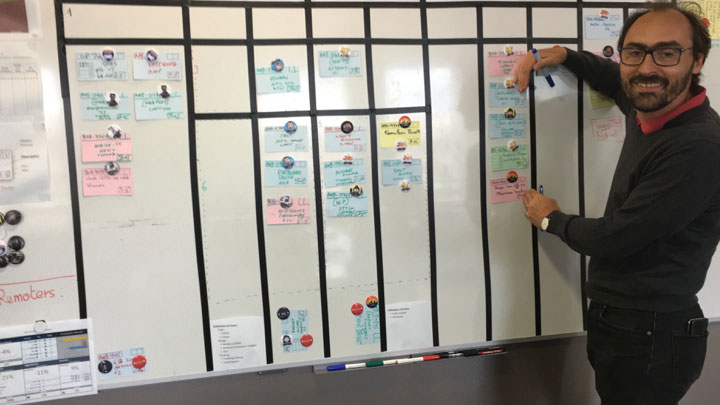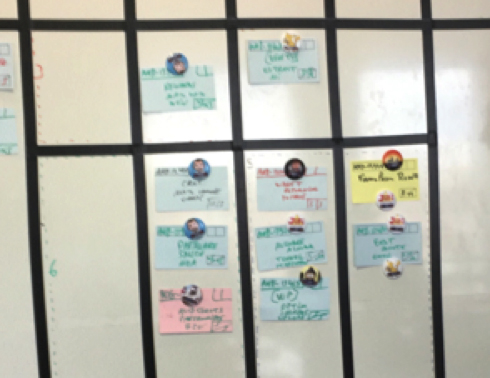Dear Gemba Coach,
Why do you insist so much on visualizing information?
Visualizing is probably the wrong word – a better one would be materializing. On the gemba, at a very basic level, we have three simple – but hard – problems:
- Understand what is going on. Reality is often complex and messy, and we live in the fog of war, as well as the added fog created by our own wrongheaded ideas and wishful thinking.
- Share this understanding. Forge a collective understanding of the issues we face so we can learn to help each other in solving our problems (as opposed to each person coming up with a way to solve their problem, even if it is to the detriment of others in the team and the overall outcome).
- Learn from doing and being flexible when plans don’t work out the way we expected. We can still strive for the outcome even though surprises blow up in our faces. And we can still work as a team to get the job done, overcome obstacles, and learn how to do the work better.
We think very differently with our hands than with our heads. Thinking with words pulls us toward abstractions. Thinking with objects or in pictures pulls us towards concrete understanding.
When thinking about any problem, there is always a risk of remaining at a surface level of abstraction that explains the problem away without ever really explaining anything. Deep thinking is about finding explanations that are a better fit-to-fact and progressively uncover concrete mechanisms that explain these facts.
For instance, on the gemba, my friend Dimitri Baeli, president of Lean Kanban France and CTO at LesFurets.com, uses “agile” style kanban to visualize the production of his IT teams.

Visualizing the workflow of something that is essentially hidden in the computers of the developers allows a more concrete understanding of what is being worked on, what is stuck and needs attention, and what priorities are made across the different steps of this flow.
Furthermore, face-to-face discussion is great for social interaction, but a very poor way of communicating because the social aspect tends to take over. In companies, the hierarchical dimension makes face-to-face discussions profoundly asymmetrical (no matter how much of a “good boss” you try to be), and people rarely say exactly what they think to their bosses – they’re always worried about his or her reaction, and they often have an angle to pursue.
We’re Suckers
By visualizing the situation – and in this case, materializing the information in the shape of “tickets” – the discussion is a lot easier as the boss and the employee can stand side-to-side and face the problem, and have a much easier discussion. As I understand it, 60% of the brain is involved in vision in one way or other, whether vision only, or vision/touch, vision/action, vision/attention or vision/navigation and, to the point, vision/meaning.
In practice this means we’re suckers for visual puzzles and that when we’re put in front a material mechanism, much of the social interaction goes to the background, and we just get drawn into understanding what we see together. Visualization leads to very different conversations more focused on finding out what is happening rather than on imposing one’s outlook.
This makes it easier to see the consequences of our collective plans when things don’t work out the way we want them to, and therefore be more flexible in our responses in order to reach our targets.
Beyond the seeing together, understanding together, and acting together, visualizing work also allows us to ask deeper questions about … how well we visualize work. For instance, in the previous case:

What we’re really seeing is the gap between one piece flow and what is currently happening. The top line is the main flow, the columns under it show WIP that for one reason or other, hasn’t progressed to the next step.
Although this visualization reveals the accumulation of work, it doesn’t explain it or leaves clear space for the people themselves to write their hypotheses of why such and such piece of work (represented by a card) is not flowing to the next step. In fact, there are many interesting issues hidden in this overflow, such as overproduction (work that isn’t necessary right now but that we’ve done because we had time on our hands) or rework (work that isn’t progressing because in fact it has been bounced back by the next step and it’s being redone) and so on.
The aim of good visual management is to lead us, as a team, always closer to the real problems we should address to be better not just in delivery, but in the quality of the delivery – and as we can see here, there is a link between the quality of the visual management tools and the relevance of the issues they point to (in other words, how well do the visual management tools perform in orienting us towards the right problems, problems which, if we solve them, will allow us to gain visibly in our own technical abilities).
See with Your Feet
Visualizing things has two profound effects:
- Shares our understanding of problems and of how we respond as a team. It materializes ambiguous information so that we can all think concretely about what is going on and how we deal with it together, as a team – which is very powerful.
- Reflects on our own mental models to look at the situation differently and think more deeply. By clarifying what we look at, by visualizing it, we also make explicit our mental models, our assumptions about how we frame the issue, which is the first step to rethinking and furthering our understanding.
In the previous example, Dimitri could show his local manager that by not being more precise in visualizing the work in progress (the cards accumulating at the bottom of the board) the teams were focused on getting the work done. They were ignoring actual obstacles to performance that individuals were meeting at given times – why couldn’t work flow completely be one-piece-flow? This new discussion led to issues about scheduling, working together, and lack of cooperation during hand-offs due to very specialized skill sets – further opportunities for kaizen, which started with further improvement of the visual board itself.
My father’s sensei used to say that his own teacher, Taichi Ohno , taught him to “see with your feet, think with your hands.” Visualizing, or more precisely, materializing information is the key to thinking concretely about abstract problems – and to learn by doing.






